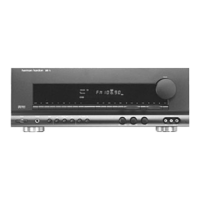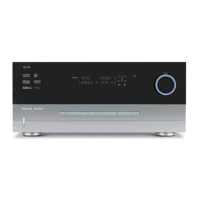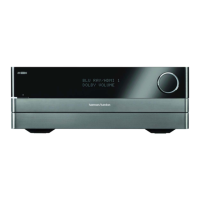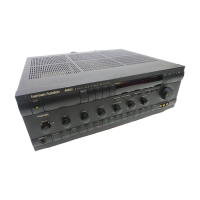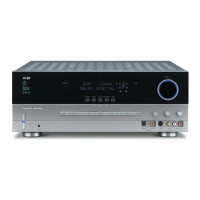26 SYSTEM CONFIGURATION
System Configuration
turn up the volume until you can hear the noise
clearly.
IMPORTANT NOTE: Because this test noise will
have a much lower level than normal music, the
volume must be lowered after the adjustment for
all channels is made, but BEFORE you return to
the main menu and the test tone turns off.
NOTE: This is a good time to verify that the
speakers have been properly connected. As the
test noise circulates, listen to make certain that
the sound comes from the speaker position indi-
cated by the on-screen cursor
›
. If the sound
from a speaker location does NOT match the
position indicated, turn the AVR 7000 off using
the Main Power Switch
1
and check the
speaker wiring to make certain that each speaker
is connected to the correct output terminal.
After checking for speaker placement, let the test
noise circulate again, and listen to see which
channels sound louder than the others. Using the
front left speaker as a reference, press the
‹
/
›
buttons
9
on the remote to bring all
speakers to the same volume level. Note that
when one of the
‹
/
›
buttons is pushed, the test
noise circulation will pause on the channel being
adjusted to give you time to make the adjust-
ment.When you release the button, the circula-
tion will resume after five seconds. The on-screen
cursor
›
can also be moved directly to the
speaker to be adjusted by pressing the
⁄
/
¤
but-
tons
6
on the remote.
Continue to adjust the individual speakers until
they all have the same volume. Note that adjust-
ments should be made with the
‹
/
›
buttons
9
on the remote only, NOT the main vol-
ume controls.
NOTE: The subwoofer output level is not
adjustable using the test tone. To change the
subwoofer level, follow the steps for Output
Level Trim Adjustment on page 33.
When all channels have an equal volume level,
the adjustment is complete. Lower the Volume
*
to about - 40dB, otherwise the listen-
ing level will be too high as soon as music starts
to play. To exit this menu, press the
⁄
/
¤
buttons
6
until the on-screen
›
cursor is next to the
RETURN TO MENU line, and then press
the Set button
8
to turn the test tone off and
return to the main AUDIO SETUP menu.
The output levels may also be adjusted at any
time using the discrete buttons and semi-OSD
system. To adjust the output levels in this fash-
ion, press the Test Tone Selector
Ù
4
.As
soon as the button is pressed, the test tone will
begin to circulate as indicated earlier. The correct
channel from which the test noise should be
heard will be shown in the lower third of the
video screen and in the Main Information
Display
W
. As an added assist, while the test
noise is circulating, the proper channel position
will also be indicated in the Speaker/Channel
Indicators
P
by a blinking letter within the
correct channel. Turn up the Volume
*
until you can hear the noise clearly.
To adjust the output level, press the Selector
buttons on the front panel
5
or the
⁄
/
¤
but-
tons
6
until the desired level is shown in the
display or on screen. Once the buttons are
released, the test noise will begin to circulate
again in five seconds.
When all channels have the same output level,
lower the Volume
*
to about
- 40dB, and press the Test Tone Selector
Ù
4
button again to turn the test tone off
and complete the process.
IMPORTANT NOTE: The Output level adjust-
ment made will be effective for all inputs, but
only for the actual surround mode selected. To be
effective for any other mode select that mode
(with any input) and repeat the level adjustment
described above. This will also allow you to com-
pensate level differences between speakers, that
may be different with each surround mode, or to
increase or decrease the level of certain speakers
intentionally, depending on the surround mode
selected.
Note: Output level adjustment is not available
for the VMAx or Surround Off mode, as no sur-
round speakers are used (so level differences
between the speakers in the room cannot occur).
But to compensate level differences between
stereo, VMAx and other surround modes (inde-
pendently from the input selected) the outputs
can be adjusted with the Level Trim Adjustment
procedure, see page 33, also for the Surround Off
(Stereo) and VMAx modes.
Once the settings outlined on the previous pages
have been made, the AVR 7000 is ready for oper-
ation. While there are some additional settings to
be made, these are best done after you have had
an opportunity to listen to a variety of sources
and different kinds of program material.These
advanced settings are described in pages 35-38
of this manual. In addition, any of the settings
made in the initial configuration of the unit may
be changed at any time. As you add new or dif-
ferent sources or speakers, or if you wish to
change a setting to better reflect your listening
taste, simply follow the instructions for changing
the settings for that parameter as shown above
and on pages 35-38. Note that any settings
changed at any time, also when the discrete but-
tons are used only, will be stored in memory in
the AVR7000, also if it´s turned off completely,
unless it will be reset (see page 51). They will
either depend on the input (Speaker configura-
tion, analog/digital input selection, surround
mode) or on the surround mode selected (speak-
er output level, delay) or be independent from
any input or surround mode (crossover), as
described on former pages.
Having completed the setup and configuration
process for your AVR 7000, you are about to
experience the finest in music and home theater
listening. Enjoy!

